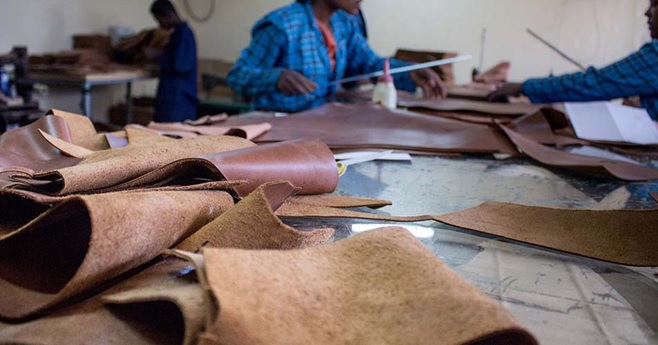
Some research indicates that more than 80% of single leather becomes waste during the tanning process. This is mainly as a result of the backward process of tannery employed in the country as well as the poor skill of human resource. Otherwise, according to experts it would have been possible to minimize the wastage down from 80% using modern technology and trained human power. As a result the leather industry is known to be a major cause of pollution.
The leather industry in Ethiopia has considerable potential for economic development, largely due to its substantial livestock population. However, the country has not fully harnessed this sector’s capabilities.
Several obstacles impede the advancement of Ethiopia’s leather industry. Many tanneries operate with outdated machinery and methods, resulting in inferior leather products that struggle to compete globally. Additionally, shortage of skilled labor worsens the situation, as existing training programs are inadequate and fail to align with the industry’s growing demands.
The traditional tanning processes employed also pose significant challenges, as they involve harmful chemicals that contribute to severe pollution of water and air. The improper disposal of tannery waste endangers local communities’ health and exacerbates environmental issues, such as through soil and water contamination.
To address these environmental issues, tanneries are partnering with leather research centers to create effective treatment strategies. This collaboration aims to reduce air pollution and foster sustainable practices in the industry.
The government encourages public private partnership (PPP) for effective initiatives aimed at reducing environmental harm. These efforts focus on promoting ecofriendly tanning techniques that minimize the use of hazardous chemicals, thereby decreasing pollution levels.
According to leather industry data, the by-products generated from the tanning process can be repurposed, turning potential waste into valuable resources such as leather products and organic fertilizers for soil fertility enhancement. So, for this recycling process, the government is actively supporting these efforts, recognizing the significance of sustainable practices in the leather sector
Additionally, the Ministry of Industry has disclosed its interests to collaborate with the leather manufacturing industry development to address the sector’s bottlenecks. This collaboration aims to enhance the effectiveness of the industry by focusing on specific challenges faced at the factory and company levels. By fostering a cooperative environment, stakeholders hope to streamline operations and boost productivity.
The Leather and Leather Products Industry Research and Development Center has recently reported that Ethiopia earned approximately 8.3 million USD from exports of leather and leather products over the past four months. This revenue serves as a crucial indicator of the sector’s potential, yet it also underscores the untold challenges that the industry faces as it navigates a complex global market.
Mohammed Hussein, The Center Manager’s Representative, told The Ethiopian Press Agency that out of these earnings around 4.9 million USD was generated from exports by tanneries. Tanneries play a vital role in the leather supply chain, transforming raw hides into finished leather products. Additionally, 700,000 USD was earned from leather glove manufacturers, highlighting the diverse range of products in the industry, he said.
He also mentioned that Handbags also contributed to the revenue, generating 600,000 USD from exports, while value-added exports of leather by-products accounted for 1.4 million USD. Despite these figures, officials have expressed concerns that this foreign exchange income falls short of expectations, indicating room for growth and improvement.
He emphasized ongoing efforts to enhance both production efficiency and product quality. One significant issue is the reliance on exports to China, which remains the primary destination for Ethiopia’s leather products. However, exports to this market had significantly declined during the COVID-19 pandemic, causing considerable concern among industry stakeholders. Fortunately, there are signs of recovery as shipments to China are gradually resuming, providing a ray of hope for the sector.
Domestic challenges also pose significant hurdles for the leather industry. Several companies that previously held substantial export shares to the United States have ceased operations due to various internal reasons. One notable example is the Huajian Shoe Factory, which had been a major exporter of leather products to the US. Mohammed confirmed that the company has now resumed production and is actively sending samples to markets in Africa and beyond. This resurgence is a positive development, but it underscores the volatility of the industry and the need for sustained support.
A critical issue highlighted by Mohammed is the ongoing demand for cow, sheep, and other skins, which remains unmet due to the departure of leather collectors from the market. This gap in the supply chain has made it increasingly difficult for industries to obtain the raw materials they need for production. The absence of reliable suppliers can lead to production delays and increased costs, ultimately affecting the competitiveness of Ethiopian leather products on the global stage.
Moreover, the leather sector grapples with transparency issues between suppliers and buyers. The presence of numerous non-value-adding actors in the market complicates the landscape for leather producers, making it challenging to establish reliable supply chains. Rising salt prices is also a critical component in leather processing that further exacerbates the situation, adding financial strain to producers already operating on thin margins.
In response to these challenges, he also pointed to recent macroeconomic reforms aimed at revitalizing the manufacturing industry. These reforms are intended to strengthen sectors that have been weakened, including leather production. He noted that these changes are beneficial for leather manufacturers, particularly in securing foreign currency needed for importing essential chemicals for production. This is a critical factor, as access to high-quality inputs directly influences the quality of the final products.
One of the most significant aspects of these reforms is the allowance for manufacturers to retain 50% of the foreign currency earned from exports. This policy shift enables manufacturers to manage their accounts with greater flexibility, allowing them to utilize the funds for importing necessary inputs. The new system is expected to alleviate some of the foreign exchange difficulties that have previously hindered production, offering a pathway for growth.
The challenges faced by the leather industry underscore the need for coordination among stakeholders to enhance the sector’s resilience. With the right support and strategic initiatives, Ethiopia’s leather industry has the potential to recover and thrive in the global market, contributing significantly to the country’s economy. The involvement of various stakeholders, including government agencies, private sector players, and international partners, will be crucial in fostering an environment conducive to growth.
As the industry moves forward, officials remain optimistic that with continued efforts to tackle existing challenges and improve production capabilities, Ethiopia can reclaim its position as a key player in the global leather market. The potential for job creation, increased foreign exchange earnings, and enhanced economic stability is significant. With a renewed focus on sustainability, quality, and innovation, the Ethiopian leather industry can navigate the complexities of the global market and emerge stronger than before.
BY FIKADU BELAY
THE ETHIOPIAN HERALD TUESDAY 10 DECEMBER 2024




